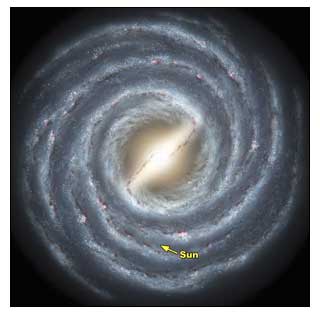BOSTON, Dec. 14 -- Nearly 100 new star clusters, each containing tens to hundreds of never before seen stars, were recently discovered in the Milky Way by the Galactic Legacy Infrared Mid-Plane Survey Extraordinaire (GLIMPSE) team of astronomers.
Boston University (BU) doctoral student Emily Mercer, lead investigator for GLIMPSE, used the dust-piercing infrared eyes of NASA's Spitzer space telescope to develop a computer method that used an algorithm to automatically sift GLIMPSE data and identify high star-density areas to look for clusters. She said the new clusters will tell astronomers a great deal about the structure of the Milky Way and star formation within the galaxy.

FRESH GLIMPSE: The Milky Way, it turns out, is no ordinary spiral galaxy. According to a massive new survey of stars at the heart of the galaxy, the Milky Way has a definitive bar feature -- some 27,000 light years in length -- that distinguishes it from pedestrian spiral galaxies, as shown in this artist's rendering. The survey, conducted using NASA's Spitzer Space Telescope, sampled light from an estimated 30 million stars in the plane of the galaxy in an effort to build a detailed portrait of the inner regions of the Milky Way. (Illustration courtesy NASA/JPL-Caltech/R. Hurt [SSC/Caltech])
Because the sun and its solar system sit inside the Milky Way's flat disk, from Earth, most of the galaxy is seen to be concentrated in a blurry band of light that stretches across the sky, known to astronomers as the galactic plane. Many of the stars in the plane cannot be seen with visible light or ultraviolet telescopes because the clouds of dust and gas that fill the galactic spiral arms block their starlight from view.
By turning Spitzer's heat-seeking infrared eyes on the Milky Way's plane, the cold clouds of galactic gas and dust became transparent, revealing almost 100 new star clusters. Two-thirds of the new clusters were discovered through the computer method Mercer developed, and the rest were found using the traditional method of visually scrutinizing GLIMPSE images for star clusters.
In addition to uncovering hundreds of hidden stars, Mercer also found there are nearly twice as many star clusters in the portion of the galactic plane only visible from Earth's southern hemisphere than in the northern galactic plane. She said this observation may reveal to astronomers the location and nature of the Milky Way's spiral arms -- the long, bright lanes of hot, massive stars seen in other galaxies but hidden by the dust in our own. Mercer's findings appear in the Dec. 10 issue of The Astrophysical Journal.
The multi-institutional GLIMPSE team is led by Professor Edward Churchwell of the University of Wisconsin-Madison, and includes Mercer, BU astronomy professor Dan Clemens and other researchers in the Boston University Institute for Astrophysical Research and researchers at other institutions. The group was approved to survey the galactic plane with Spitzer's Infrared Array Camera in 2000 as part of Spitzer's Legacy program. Thus far, more than 30 million stars in the inner Milky Way have been catalogued by GLIMPSE, and the team expects to identify more than 50 million stars by the end of the project.
For more information, visit: www.astro.wisc.edu/sirtf/